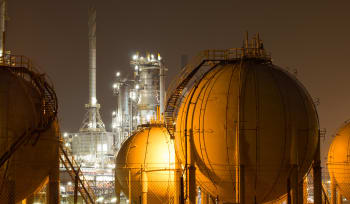This informal CPD article on Addressing the Threat of Fire in Storage Tanks was provided by Patol, a privately owned British leading company in designing and manufacturing specialist fire detection products.
There are many hazardous environments which pose particularly high risks in terms of fire safety. Amongst the most hazardous are those which involve the storage of highly flammable substances, including refineries, petrochemical, gas processing, terminal and offshore facilities. The level of hazard is indicated by the collective description for such installations – major hazard installations (MHIs). Fire and explosion is cited as the biggest contributor to monetary loss at refinery and petrochemical sites. There is also the potential risk to life, as well as the impact on the surrounding communities, not only from the fire but also from the consequential damage that often results from fighting the fire. For all these reasons, fire safety is a crucial factor in such facilities.
One of the fundamental storage methods employed is the atmospheric storage tank. This is designed to hold liquids under little or no pressure, unlike the pressurised tank, which, as is evident from its name, creates a pressurised environment. Often the liquids – or the gases the liquids give off – are volatile, highly flammable or even explosive. Amongst the hazardous fluids stored in this kind of tank are liquid fuels such as automotive oils, petrol, alcohol, methanol, ethanol, propanol, and butanol, biodiesel, diesel, gasoline, aviation fuel, paraffin and other chemicals.
Most liquids can leak, bleed or even evaporate, releasing flammable fumes through even the smallest fault or aperture. Special care must therefore be taken to ensure the safe operation of those tanks containing such hazardous liquids. The release of a flammable material can result in a number of different scenarios, from a pool fire, jet fire, flash fire or flare to a fireball or unconfined vapour cloud explosion. Not surprisingly, therefore, there are many environmental regulations applied to the design and operation of atmospheric storage tanks, depending on the nature of the fluids contained. Many of these regulations naturally apply to the prevention of the ignition of the liquids and gases.
Different tank types
Atmospheric storage tanks can be open or closed at the top. However, as well as – or instead of – a fixed top, some have a ‘floating’ roof. This is a structure that rises and falls depending on the level of the fluid inside the tank. In many industries, including petroleum refinery, floating roofs are a prerequisite for safety, as well as a preventative measure against atmospheric pollution, as they keep the combustible vapour above the liquid level to a manageable minimum.
Dangers when full or empty
Most people are aware of the many extreme dangers involved in the storage of highly flammable liquids in confined spaces – the ever-present possibility of fire or explosion. The scale of the problem in these major hazard installations is highlighted by the number of fires that have occurred in crude oil storage tanks alone – in a period of just over 50 years (1951 to 2003) some 480 tank fire incidents were recorded worldwide with lightning cited as the major cause. The threat to lives is obviously the prime consideration in identifying ways to reduce the number of incidents but there are also the financial losses they represent given that storage tanks are important capital assets and often central elements in critical operations. Business continuity is therefore a consideration, as are the significant environmental consequences that a fire can have, both in terms of the fire itself and in the efforts required to extinguish it.
While the fire hazard presented by full tanks is fairly obvious to all, perhaps more surprisingly for the uninitiated, these same tanks can also present a problem even when empty. If they have been used to hold volatile products such as the previously mentioned fuels and are left untreated, the atmosphere in the tanks will probably be filled with an explosive residue of hydrocarbon fumes. These will be highly flammable and, if ignited, could explode with disastrous consequences, causing catastrophic damage.
There is also the potential for a phenomenon known as Boiling Liquid Expanding Vapour Explosion (BLEVE). This is caused by an external fire affecting a storage tank, heating the liquid contents and resulting in a build-up of pressure. If the relief valve of the tank is not designed to vent the vapour as quickly as it is generated, or in the event of a malfunction of the relief valve, the tank may fail completely. This can result in an explosion, projecting vessel fragments throughout the surrounding area. These fragments can cause significant damage, with the potential to puncture pipework or other tanks in the vicinity (several storage tanks tend to be sited in the same area), causing a domino effect. Records show that in the event of a BLEVE, fragment projectiles have been known to travel up to a mile from the source of the explosion.
‘Intrinsic Safety’ techniques
One of the prime causes of fires and incidents involving atmospheric storage tanks is worn or damaged rim seals on the floating roofs. The designs of the tanks can vary from manufacturer to manufacturer and from site to site, depending on local needs. Irrespective of the size and design of the tank, one obvious overriding concern for any detection or activation of a fire suppression system would be the use of electrical equipment in hazardous areas with combustible liquids and atmospheres. These kinds of hazards require the implementation of ‘Intrinsic Safety’ (IS) techniques, that is, the use of systems using certified IS barriers or isolators.
The technique behind intrinsic safety is to ensure that the available electrical and thermal energy in the instrumentation of the system implemented is always sufficiently low that ignition cannot occur. IS barriers are able to provide protection for the safe operation of electrical equipment such as detection and activation systems in hazardous areas, even those classified as Zone 0 (i.e. those areas in which an explosive mixture is continuously present or present for long periods).
LHDC – a simple contributor to tank safety
‘Simple apparatus’ has been in use as a valuable part of intrinsically safe systems for at least fifty years. The term, defined by Clause 5.4 of BSEN50020: 2002 , is used to describe and limited to only pieces of apparatus that are fundamentally simple – and the safety of which can be readily verified by the visual inspection of a competent engineer with reference to available data. Certification to the ATEX Directive or any other notified body is not required as they have no own source of ignition because of the low levels of energy. However, even though a device is considered to be ‘simple apparatus’, it must be connected to an Intrinsic Safety barrier. Examples of this ‘simple apparatus’ are discrete switch inputs, such as pressure switches, key switches and digital linear heat detection cable.
Linear heat detection cable (LHDC) can be used as a stand-alone detection system or in tandem with a suppression system to activate the release of extinguishing products to protect atmospheric storage tanks against the outbreak of fire. The digital LHDC is a two-core cable that reacts when exposed to a small flame. The reactive polymer insulators that cover each cable melt at a pre-determined alarm temperature causing the two inner conductors or cables to fuse together, thus creating a switched circuit.
Protecting the rim seal
LHDC?should be mounted above the rim seal of the floating roof such that it will readily detect any ignition of leaked vapour that may occur. There are considerable variations in the way that rim seals are mechanically arranged and fixed. Each should be separately and thoroughly inspected in order to determine the most suitable and practical mounting method for the cable. Brackets carrying the cable are usually fixed to cover the motion point of the pontoon’s secondary seals at the wall of the tank. Brackets for the LHDC can also be mounted to the primary scissors (or ‘pantograph’) seal.
As the pontoon for the floating roof rises and falls with the varying levels of the liquid contained within the tank, electrical connection between the detection cable and the control panel can sometimes prove problematic, so an ATEX-approved automatic cable reeler, with a 23 metre 4 core cable, is used to maintain contact. Two cores are used to supply the LHDC and the other two cores are used to connect an end-of-line monitoring resistor, which can be located outside the tank. The cable reeler is installed on the rim at the top of the tank and connected to the junction box on top of the roof of the floating pontoon, continually adjusting to its movement. The reeler automatically dispenses more cable as the level of the stored liquid falls and winds it back in whenever the level rises.
These cable reelers are enclosed within a cabinet of 316 grade stainless steel. Alternatively, a self-supporting, four-core coiled cable can be used with a stainless steel cable collector on the top of the floating roof pontoon. The coiled cable is connected between two junction boxes – one positioned on the floating roof and the other on the rim at the top of the tank.
We hope this article was helpful. For more information from Patol, please visit their CPD Member Directory page. Alternatively please visit the CPD Industry Hubs more CPD articles, courses and events relevant to your Continuing Professional Development requirements.













